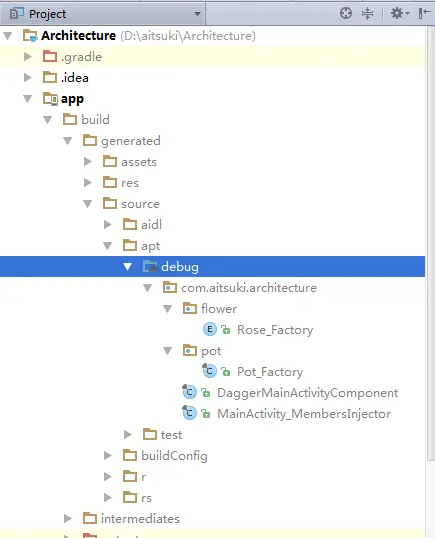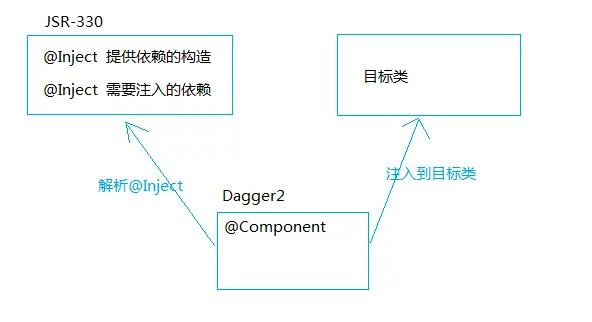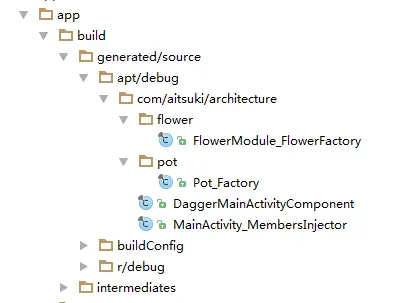部分内容参考自:
[Android]使用Dagger 2依赖注入 - DI介绍(翻译)
[Android]使用Dagger 2依赖注入 - API(翻译)
为什么网上这么多dagger2教程,我还写了这篇文章。
- 找了很多Dagger2相关的博客,我看的脑浆炸裂……
- Dagger2给我们带来了什么,大多数博文也没有说明
- 手动写写,加深印象,骗骗粉丝 (手动滑稽)
- 部分Dagger2的运作机制是我个人的臆测,比如Dagger2编译入口,不过应该八九不离十吧,测试了挺多次的,没有@Component的话是不会编译的=。=
一、Dagger2使用Q&A
Q1:dagger2是什么,有什么用?
A1:dagger2是一个基于JSR-330标准的依赖注入框架,在编译期间自动生成代码,负责依赖对象的创建。
Q2:什么是JSR-330
A2:JSR即Java Specification Requests,意思是java规范提要。
而JSR-330则是 Java依赖注入标准
关于JSR-330可以阅读这篇文章Java 依赖注入标准(JSR-330)简介,随便看下就好了,不是重点。
Q3:用dagger2提供依赖有什么好处
A:3:为了进一步解耦和方便测试,我们会使用依赖注入的方式构建对象。(可以看这篇文章使用Dagger2前你必须了解的一些设计原则)
但是,在Activity中有可能出现这样的情况。
public class LoginActivity extends AppCompatActivity {
LoginActivityPresenter presenter;
@Override
protected void onCreate(Bundle savedInstanceState) {
super.onCreate(savedInstanceState);
OkHttpClient okHttpClient = new OkHttpClient();
RestAdapter.Builder builder = new RestAdapter.Builder();
builder.setClient(new OkClient(okHttpClient));
RestAdapter restAdapter = builder.build();
ApiService apiService = restAdapter.create(ApiService.class);
UserManager userManager = UserManager.getInstance(apiService);
UserDataStore userDataStore = UserDataStore.getInstance(
getSharedPreferences("prefs", MODE_PRIVATE)
);
//Presenter is initialized here
presenter = new LoginActivityPresenter(this, userManager, userDataStore);
}
} 其实我们需要的只是LoginActivityPresenter对象,但是因为使用依赖注入的原因,我们不得不在LoginActivity中初始化一大堆Presenter所需要的依赖。
现在不仅依赖于LoginActivityPresenter,还依赖OkHttpClient ,UserManager ,RestAdapter等。它们之中任何一个的构造改变了,或者Presenter构造改变了,我们都需要反复修改LoginActivity中的代码。
而dagger框架就解决了这种问题,使用dagger2框架后相同代码如下:
public class LoginActivity extends AppCompatActivity {
@Inject
LoginActivityPresenter presenter;
@Override
protected void onCreate(Bundle savedInstanceState) {
super.onCreate(savedInstanceState);
//Satisfy all dependencies requested by @Inject annotation
getDependenciesGraph().inject(this);
}
}LoginActivity瞬间清爽了。dagger2框架可以让依赖注入独立于组件之外,不管Presenter的依赖怎么改,都不会对LoginActivity的代码照成任何影响,这就是dagger2框架的好处了
二、Dagger2 API
public @interface Component {
Class<?>[] modules() default {};
Class<?>[] dependencies() default {};
}
public @interface Subcomponent {
Class<?>[] modules() default {};
}
public @interface Module {
Class<?>[] includes() default {};
}
public @interface Provides {
}
public @interface MapKey {
boolean unwrapValue() default true;
}
public interface Lazy<T> {
T get();
}还有在Dagger 2中用到的定义在 JSR-330 (Java中依赖注入的标准)中的其它元素:
public @interface Inject {
}
public @interface Scope {
}
public @interface Qualifier {
}三、@Inject和@Component
先来看一段没有使用dagger的依赖注入Demo
MainActivity依赖Pot, Pot依赖Rose
public class Rose {
public String whisper() {
return "热恋";
}
}public class Pot {
private Rose rose;
@Inject
public Pot(Rose rose) {
this.rose = rose;
}
public String show() {
return rose.whisper();
}
}public class MainActivity extends AppCompatActivity {
private Pot pot;
protected void onCreate(@Nullable Bundle savedInstanceState) {
super.onCreate(savedInstanceState);
Rose rose = new Rose();
pot = new Pot(rose);
String show = pot.show();
Toast.makeText(MainActivity.this, show, Toast.LENGTH_SHORT).show();
}
}使用Dagger2进行依赖注入如下:
public class Rose {
@Inject
public Rose() {}
public String whisper() {
return "热恋";
}
}public class Pot {
private Rose rose;
@Inject
public Pot(Rose rose) {
this.rose = rose;
}
public String show() {
return rose.whisper();
}
}@Component
public interface MainActivityComponent {
void inject(MainActivity activity);
}public class MainActivity extends AppCompatActivity {
@Inject
Pot pot;
protected void onCreate(@Nullable Bundle savedInstanceState) {
super.onCreate(savedInstanceState);
// 这个类是重新编译后Dagger2自动生成的,所以写这行代码之前要先编译一次
// Build --> Rebuild Project
DaggerMainActivityComponent.create().inject(this);
String show = pot.show();
Toast.makeText(MainActivity.this, show, Toast.LENGTH_SHORT).show();
}
}Dagger2生成的代码保存在这里:

源码待会分析,现在先来了解下@Inject和@Component两个API,想要使用Dagger2进行依赖注入,至少要使用到这两个注解。
@Inject用于标记需要注入的依赖,或者标记用于提供依赖的方法。
@Component则可以理解为注入器,在注入依赖的目标类MainActivity使用Component完成注入。
@Inject
依赖注入中第一个并且是最重要的就是@Inject注解。JSR-330标准中的一部分,标记那些应该被依赖注入框架提供的依赖。在Dagger 2中有3种不同的方式来提供依赖:
-
构造器注入,@Inject标注在构造器上其实有两层意思。
①告诉Dagger2可以使用这个构造器构建对象。如Rose类
②注入构造器所需要的参数的依赖。 如Pot类,构造上的Rose会被注入。
构造器注入的局限:如果有多个构造器,我们只能标注其中一个,无法标注多个。 -
属性注入
如MainActivity类,标注在属性上。被标注的属性不能使用private修饰,否则无法注入。
属性注入也是Dagger2中使用最多的一个注入方式。 -
方法注入
public class MainActivity extends AppCompatActivity { private Pot pot; protected void onCreate(@Nullable Bundle savedInstanceState) { super.onCreate(savedInstanceState); DaggerMainActivityComponent.create().inject(this); String show = pot.show(); Toast.makeText(MainActivity.this, show, Toast.LENGTH_SHORT).show(); } @Inject public void setPot(Pot pot) { this.pot = pot; } }标注在public方法上,Dagger2会在构造器执行之后立即调用这个方法。
方法注入和属性注入基本上没有区别, 那么什么时候应该使用方法注入呢?
比如该依赖需要this对象的时候,使用方法注入可以提供安全的this对象,因为方法注入是在构造器之后执行的。
比如google mvp dagger2中,给View设置Presenter的时候可以这样使用方法注入。/** * Method injection is used here to safely reference {@code this} after the object is created. * For more information, see Java Concurrency in Practice. */ @Inject void setupListeners() { mTasksView.setPresenter(this); }
@Component
@Inject注解只是JSR-330中定义的注解,在javax.inject包中。
这个注解本身并没有作用,它需要依赖于注入框架才具有意义,用来标记需要被注入框架注入的方法,属性,构造。
而Dagger2则是用Component来完成依赖注入的,@Component可以说是Dagger2中最重要的一个注解。
@Component
public interface MainActivityComponent {
void inject(MainActivity activity);
} 以上是定义一个Component的方式。使用接口定义,并且@Component注解。
命名方式推荐为:目标类名+Component,在编译后Dagger2就会为我们生成DaggerXXXComponent这个类,它是我们定义的xxxComponent的实现,在目标类中使用它就可以实现依赖注入了。
Component中一般使用两种方式定义方法。
void inject(目标类 obj);Dagger2会从目标类开始查找@Inject注解,自动生成依赖注入的代码,调用inject可完成依赖的注入。Object getObj();如:Pot getPot();
Dagger2会到Pot类中找被@Inject注解标注的构造器,自动生成提供Pot依赖的代码,这种方式一般为其他Component提供依赖。(一个Component可以依赖另一个Component,后面会说)
Component和Inject的关系如下:

Dagger2框架以Component中定义的方法作为入口,到目标类中寻找JSR-330定义的@Inject标注,生成一系列提供依赖的Factory类和注入依赖的Injector类。
而Component则是联系Factory和Injector,最终完成依赖的注入。
我们看下源码(请对应上面的Dagger2 apt图一起看):
Rose_Factory和Pot_Factory分别对应Rose类和Pot类的构造器上的@Inject注解。
而Factory其实是个Provider对象
public interface Provider<T> {
/**
* Provides a fully-constructed and injected instance of {@code T}.
*
* @throws RuntimeException if the injector encounters an error while
* providing an instance. For example, if an injectable member on
* {@code T} throws an exception, the injector may wrap the exception
* and throw it to the caller of {@code get()}. Callers should not try
* to handle such exceptions as the behavior may vary across injector
* implementations and even different configurations of the same injector.
*/
T get();
}public interface Factory<T> extends Provider<T> {}为什么这里要使用枚举作为提供Rose对象的Provide我也不太清楚,反正能提供就对了=。=
public enum Rose_Factory implements Factory<Rose> {
INSTANCE;
@Override
public Rose get() {
return new Rose();
}
public static Factory<Rose> create() {
return INSTANCE;
}
}Pot对象依赖Rose,所以直接将RoseProvide作为参数传入了。
public final class Pot_Factory implements Factory<Pot> {
private final Provider<Rose> roseProvider;
public Pot_Factory(Provider<Rose> roseProvider) {
assert roseProvider != null;
this.roseProvider = roseProvider;
}
@Override
public Pot get() {
return new Pot(roseProvider.get());
}
public static Factory<Pot> create(Provider<Rose> roseProvider) {
return new Pot_Factory(roseProvider);
}
}MainActivity上的@Inject属性或方法注解,则对应MainActivity_MembersInjector类
public interface MembersInjector<T> {
/**
* Injects dependencies into the fields and methods of {@code instance}. Ignores the presence or
* absence of an injectable constructor.
*
* <p>Whenever the object graph creates an instance, it performs this injection automatically
* (after first performing constructor injection), so if you're able to let the object graph
* create all your objects for you, you'll never need to use this method.
*
* @param instance into which members are to be injected
* @throws NullPointerException if {@code instance} is {@code null}
*/
void injectMembers(T instance);
}public final class MainActivity_MembersInjector implements MembersInjector<MainActivity> {
private final Provider<Pot> potProvider;
public MainActivity_MembersInjector(Provider<Pot> potProvider) {
assert potProvider != null;
this.potProvider = potProvider;
}
public static MembersInjector<MainActivity> create(Provider<Pot> potProvider) {
return new MainActivity_MembersInjector(potProvider);
}
@Override
public void injectMembers(MainActivity instance) {
if (instance == null) {
throw new NullPointerException("Cannot inject members into a null reference");
}
instance.pot = potProvider.get();
}
public static void injectPot(MainActivity instance, Provider<Pot> potProvider) {
instance.pot = potProvider.get();
}
} 最后是DaggerMainActivityComponent类,对应@Component注解就不多说了。这是Dagger2解析JSR-330的入口。
它联系Factory和MainActivity两个类完成注入。
public final class DaggerMainActivityComponent implements MainActivityComponent {
private Provider<Pot> potProvider;
private MembersInjector<MainActivity> mainActivityMembersInjector;
private DaggerMainActivityComponent(Builder builder) {
assert builder != null;
initialize(builder);
}
public static Builder builder() {
return new Builder();
}
public static MainActivityComponent create() {
return builder().build();
}
@SuppressWarnings("unchecked")
private void initialize(final Builder builder) {
this.potProvider = Pot_Factory.create(Rose_Factory.create());
this.mainActivityMembersInjector = MainActivity_MembersInjector.create(potProvider);
}
@Override
public void inject(MainActivity activity) {
mainActivityMembersInjector.injectMembers(activity);
}
public static final class Builder {
private Builder() {}
public MainActivityComponent build() {
return new DaggerMainActivityComponent(this);
}
}
} 只使用几个注解,Dagger2就默默中为我们做了这么多事情,太感动了……
看完这个,相信大家已经完全理解了@Inject和@Component两个注解的作用了,要区分的是,@Inject是JSR330定义的,而@Component是Dagger2框架自己定义的。
四、@Module和@Provides
使用@Inject标记构造器提供依赖是有局限性的,比如说我们需要注入的对象是第三方库提供的,我们无法在第三方库的构造器上加上@Inject注解。
或者,我们使用依赖倒置的时候,因为需要注入的对象是抽象的,@Inject也无法使用,因为抽象的类并不能实例化,比如:
public abstract class Flower {
public abstract String whisper();
}public class Lily extends Flower {
@Inject
Lily() {}
@Override
public String whisper() {
return "纯洁";
}
}public class Rose extends Flower {
@Inject
public Rose() {}
public String whisper() {
return "热恋";
}
}public class Pot {
private Flower flower;
@Inject
public Pot(Flower flower) {
this.flower = flower;
}
public String show() {
return flower.whisper();
}
} 修改下Demo,遵循依赖倒置规则。但是这时候Dagger就报错了,因为Pot对象需要Flower,而Flower是抽象的,无法使用@Inject提供实例。

这时候就需要用到Module了。
清除Lily和Rose的@Inject
public class Lily extends Flower {
@Override
public String whisper() {
return "纯洁";
}
}public class Rose extends Flower {
public String whisper() {
return "热恋";
}
}@Module标记在类上面,@Provodes标记在方法上,表示可以通过这个方法获取依赖。
@Module
public class FlowerModule {
@Provides
Flower provideFlower() {
return new Rose();
}
}在@Component中指定Module
@Component(modules = FlowerModule.class)
public interface MainActivityComponent {
void inject(MainActivity activity);
}其他类不需要更改,这样就完成了。
那么Module是干嘛的,我们来看看生成的类。

可以看到,被@Module注解的类生成的也是Factory。
public final class FlowerModule_FlowerFactory implements Factory<Flower> {
private final FlowerModule module;
public FlowerModule_FlowerFactory(FlowerModule module) {
assert module != null;
this.module = module;
}
@Override
public Flower get() {
return Preconditions.checkNotNull(
module.provideFlower(), "Cannot return null from a non-@Nullable @Provides method");
}
public static Factory<Flower> create(FlowerModule module) {
return new FlowerModule_FlowerFactory(module);
}
}@Module需要和@Provide是需要一起使用的时候才具有作用的,并且@Component也需要指定了该Module的时候。
@Module是告诉Component,可以从这里获取依赖对象。Component就会去找被@Provide标注的方法,相当于构造器的@Inject,可以提供依赖。
还有一点要说的是,@Component可以指定多个@Module的,如果需要提供多个依赖的话。
并且Component也可以依赖其它Component存在。
五、@Qualifier和@Named
@Qualifier是限定符,而@Named则是基于String的限定符。
当我有两个相同的依赖(都继承某一个父类或者都是先某一个接口)可以提供给高层时,那么程序就不知道我们到底要提供哪一个依赖,因为它找到了两个。
这时候我们就可以通过限定符为两个依赖分别打上标记,指定提供某个依赖。
接着上一个Demo,例如:Module可以提供的依赖有两个。
@Module
public class FlowerModule {
@Provides
Flower provideRose() {
return new Rose();
}
@Provides
Flower provideLily() {
return new Lily();
}
}
这时候就可以用到限定符来指定依赖了,我这里用@Named来演示。
@Module
public class FlowerModule {
@Provides
@Named("Rose")
Flower provideRose() {
return new Rose();
}
@Provides
@Named("Lily")
Flower provideLily() {
return new Lily();
}
}我们是通过@Inject Pot的构造器注入Flower依赖的,在这里可以用到限定符。
public class Pot {
private Flower flower;
@Inject
public Pot(@Named("Rose") Flower flower) {
this.flower = flower;
}
public String show() {
return flower.whisper();
}
}而@Qualifier的作用和@Named是完全一样的,不过更推荐使用@Qualifier,因为@Named需要手写字符串,容易出错。
@Qualifier不是直接注解在属性上的,而是用来自定义注解的。
@Qualifier
@Retention(RetentionPolicy.RUNTIME)
public @interface RoseFlower {}@Qualifier
@Retention(RetentionPolicy.RUNTIME)
public @interface LilyFlower {}@Module
public class FlowerModule {
@Provides
@RoseFlower
Flower provideRose() {
return new Rose();
}
@Provides
@LilyFlower
Flower provideLily() {
return new Lily();
}
}public class Pot {
private Flower flower;
@Inject
public Pot(@RoseFlower Flower flower) {
this.flower = flower;
}
public String show() {
return flower.whisper();
}
}我们也可以使用Module来管理Pot依赖,当然还是需要@Qualifier指定提供哪一个依赖
@Module
public class PotModule {
@Provides
Pot providePot(@RoseFlower Flower flower) {
return new Pot(flower);
}
}然后MainAcitivtyComponent需要增加一个Module
@Component(modules = {FlowerModule.class, PotModule.class})
public interface MainActivityComponent {
void inject(MainActivity activity);
}六、@Component的dependence和@SubComponent
上面也说过,Component可以依赖于其他Component,可以使用@Component的dependence,也可以使用@SubComponent,这样就可以获取其他Component的依赖了。
如:我们也用Component来管理FlowerModule和PotModule,并且使用dependence联系各个Component。
这次我就将代码贴完整点吧。
public abstract class Flower {
public abstract String whisper();
}public class Lily extends Flower {
@Override
public String whisper() {
return "纯洁";
}
}public class Rose extends Flower {
public String whisper() {
return "热恋";
}
}@Module
public class FlowerModule {
@Provides
@RoseFlower
Flower provideRose() {
return new Rose();
}
@Provides
@LilyFlower
Flower provideLily() {
return new Lily();
}
}Component上也需要指定@Qualifier
@Component(modules = FlowerModule.class)
public interface FlowerComponent {
@RoseFlower
Flower getRoseFlower();
@LilyFlower
Flower getLilyFlower();
}public class Pot {
private Flower flower;
public Pot(Flower flower) {
this.flower = flower;
}
public String show() {
return flower.whisper();
}
}PotModule需要依赖Flower,需要指定其中一个子类实现,这里使用RoseFlower
@Module
public class PotModule {
@Provides
Pot providePot(@RoseFlower Flower flower) {
return new Pot(flower);
}
}@Component(modules = PotModule.class,dependencies = FlowerComponent.class)
public interface PotComponent {
Pot getPot();
}@Component(dependencies = PotComponent.class)
public interface MainActivityComponent {
void inject(MainActivity activity);
}而在MainActivity则需要创建其依赖的Component
public class MainActivity extends AppCompatActivity {
@Inject
Pot pot;
protected void onCreate(@Nullable Bundle savedInstanceState) {
super.onCreate(savedInstanceState);
DaggerMainActivityComponent.builder()
.potComponent(DaggerPotComponent.builder()
.flowerComponent(DaggerFlowerComponent.create())
.build())
.build().inject(this);
String show = pot.show();
Toast.makeText(MainActivity.this, show, Toast.LENGTH_SHORT).show();
}
}这就是Component的dependencies的用法了,我们Component不需要重复的指定Module,可以直接依赖其它Component获得。
分析下源码,看下Component的dependencies做了什么事情。
public final class DaggerPotComponent implements PotComponent {
private Provider<Flower> getRoseFlowerProvider;
private Provider<Pot> providePotProvider;
private DaggerPotComponent(Builder builder) {
assert builder != null;
initialize(builder);
}
public static Builder builder() {
return new Builder();
}
@SuppressWarnings("unchecked")
private void initialize(final Builder builder) {
this.getRoseFlowerProvider =
new Factory<Flower>() {
private final FlowerComponent flowerComponent = builder.flowerComponent;
@Override
public Flower get() {
return Preconditions.checkNotNull(
flowerComponent.getRoseFlower(),
"Cannot return null from a non-@Nullable component method");
}
};
this.providePotProvider =
PotModule_ProvidePotFactory.create(builder.potModule, getRoseFlowerProvider);
}
@Override
public Pot getPot() {
return providePotProvider.get();
}
public static final class Builder {
private PotModule potModule;
private FlowerComponent flowerComponent;
private Builder() {}
public PotComponent build() {
if (potModule == null) {
this.potModule = new PotModule();
}
if (flowerComponent == null) {
throw new IllegalStateException(FlowerComponent.class.getCanonicalName() + " must be set");
}
return new DaggerPotComponent(this);
}
public Builder potModule(PotModule potModule) {
this.potModule = Preconditions.checkNotNull(potModule);
return this;
}
public Builder flowerComponent(FlowerComponent flowerComponent) {
this.flowerComponent = Preconditions.checkNotNull(flowerComponent);
return this;
}
}
} PotComponent依赖FlowerComponent,其实就是将FlowerComponent的引用传递给PotComponent,这样PotComponent就可以使用FlowerComponent中的方法了。
注意看getRoseFlowerProvider这个Provider,是从 flowerComponent.getRoseFlower()获取到的
如果使用Subcomponent的话则是这么写, 其他类不需要改变,只修改Component即可
@Component(modules = FlowerModule.class)
public interface FlowerComponent {
PotComponent plus(PotModule potModule);
}@Subcomponent(modules = PotModule.class)
public interface PotComponent {
MainActivityComponent plus();
}@Subcomponent
public interface MainActivityComponent {
void inject(MainActivity activity);
}public class MainActivity extends AppCompatActivity {
@Inject
Pot pot;
protected void onCreate(@Nullable Bundle savedInstanceState) {
super.onCreate(savedInstanceState);
DaggerFlowerComponent.create()
.plus(new PotModule()) // 这个方法返回PotComponent
.plus() // 这个方法返回MainActivityComponent
.inject(this);
String show = pot.show();
Toast.makeText(MainActivity.this, show, Toast.LENGTH_SHORT).show();
}
}FlowerComponent管理了PotComponent和MainActivityComponent,看起来不符合常理。
先来说说Component中的方法的第三种定义方式(上面说了两种)。
@Component
class AComponpent {
XxxComponent plus(Module... modules)
}@Subcomponent(modules = xxxxx)
class XxxComponent {
} xxxComponent是该AComponpent的依赖,被@Subcomponent标注。
而modules参数则是xxxComponent指定的Module。
在重新编译后,Dagger2生成的代码中,Subcomponent标记的类是Componpent的内部类。
像上面的Demo,MainActivityComponent是PotComponent的内部类,而PotComponent又是FlowerComponent的内部类。
但是用Subcomponent怎么看怎么别扭,各个Component之间联系太紧密,不太适合我们Demo的使用场景。
那什么时候该用@Subcomponent呢?
Subcomponent是作为Component的拓展的时候。
像我写的Demo中,Pot和Flower还有MainActivity只是单纯的依赖关系。就算有,也只能是Flower作为Pot的Subcomponent,而不是Demo中所示,因为我需要给大家展示Dagger的API,强行使用。
比较适合使用Subcomponent的几个场景:
很多工具类都需要使用到Application的Context对象,此时就可以用一个Component负责提供,我们可以命名为AppComponent。
需要用到的context对象的SharePreferenceComponent,ToastComponent就可以它作为Subcomponent存在了。
而且在AppComponent中,我们可以很清晰的看到有哪些子Component,因为在里面我们定义了很多XxxComponent plus(Module... modules)
每个ActivityComponent也是可以作为AppComponent的Subcomponent,这样可以更方便的进行依赖注入,减少重复代码。
Component dependencies和Subcomponent区别
- Component dependencies 能单独使用,而Subcomponent必须由Component调用方法获取。
- Component dependencies 可以很清楚的得知他依赖哪个Component, 而Subcomponent不知道它自己的谁的孩子……真可怜
- 使用上的区别,Subcomponent就像这样
DaggerAppComponent.plus(new SharePreferenceModule());
使用Dependence可能是这样DaggerAppComponent.sharePreferenceComponent(SharePreferenceComponent.create())
Component dependencies和Subcomponent使用上的总结
Component Dependencies:
- 你想保留独立的想个组件(Flower可以单独使用注入,Pot也可以)
- 要明确的显示该组件所使用的其他依赖
Subcomponent:
- 两个组件之间的关系紧密
- 你只关心Component,而Subcomponent只是作为Component的拓展,可以通过Component.xxx调用。
Dagger 2 subcomponents vs component dependencies
七、@Scope和@Singleton
@Scope是用来管理依赖的生命周期的。它和@Qualifier一样是用来自定义注解的,而@Singleton则是@Scope的默认实现。
/**
* Identifies a type that the injector only instantiates once. Not inherited.
*
* @see javax.inject.Scope @Scope
*/
@Scope
@Documented
@Retention(RUNTIME)
public @interface Singleton {} Component会帮我们注入被@Inject标记的依赖,并且可以注入多个。
但是每次注入都是重新new了一个依赖。如
public class MainActivity extends AppCompatActivity {
private static final String TAG = "MainActivity";
@Inject
Pot pot;
@Inject
Pot pot2;
protected void onCreate(@Nullable Bundle savedInstanceState) {
super.onCreate(savedInstanceState);
DaggerMainActivityComponent.builder()
.potComponent(DaggerPotComponent.builder()
.flowerComponent(DaggerFlowerComponent.create()).build())
.build().inject(this);
Log.d(TAG, "pot = " + pot.hashCode() +", pot2 = " + pot2.hashCode());
String show = pot.show();
Toast.makeText(MainActivity.this, show, Toast.LENGTH_SHORT).show();
}
} 打印的地址值不一样,是两个对象。
D/MainActivity: pot = com.aitsuki.architecture.pot.Pot@240f3ff5, pot2 = com.aitsuki.architecture.pot.Pot@2c79118a
假设我们需要Pot对象的生命周期和app相同,也就是单例,我们需要怎么做?这时候就可以用到@Scope注解了。
我们来使用默认的@Scope实现——@Singleton
需要在@Provide和@Component中同时使用才起作用,为什么呢,待会会说明。
@Module
public class PotModule {
@Provides
@Singleton
Pot providePot(@RoseFlower Flower flower) {
return new Pot(flower);
}
}@Singleton
@Component(modules = PotModule.class, dependencies = FlowerComponent.class)
public interface PotComponent {
Pot getPot();
} 然后我们再运行下项目,报错了

那是因为我们的MainActivityComponent依赖PotComponent,而dagger2规定子Component也必须标注@Scope。
但是我们不能给MainActivityComponent也标注@Singleton,并且dagger2也不允许。因为单例依赖单例是不符合设计原则的,我们需要自定义一个@Scope注解。
定义Scope是名字要起得有意义,能一眼就让你看出这个Scope所规定的生命周期。
比如ActivityScope 或者PerActivity,生命周期和Activity相同。
@Scope
@Retention(RetentionPolicy.RUNTIME)
public @interface ActivityScope {}@ActivityScope
@Component(dependencies = PotComponent.class)
public interface MainActivityComponent {
void inject(MainActivity activity);
} D/MainActivity: pot = com.aitsuki.architecture.pot.Pot@240f3ff5, pot2 = com.aitsuki.architecture.pot.Pot@240f3ff5
这时候我们看到两个pot对象的地址值是一样的,@Scope注解起作用了。
那么我再新建一个Activity,再次注入pot打印地址值。
public class SecondActivity extends AppCompatActivity {
private static final String TAG = "SecondActivity";
@Inject
Pot pot3;
@Override
protected void onCreate(@Nullable Bundle savedInstanceState) {
super.onCreate(savedInstanceState);
DaggerSecondActivityComponent.builder()
.potComponent(DaggerPotComponent.builder().flowerComponent(DaggerFlowerComponent.create()).build())
.build().inject(this);
Log.d(TAG, "pot3 = " + pot3);
}
}@ActivityScope
@Component(dependencies = PotComponent.class)
public interface SecondActivityComponent {
void inject(SecondActivity activity);
}在MainActivity初始化时直接跳转到SecondActivity
public class MainActivity extends AppCompatActivity {
private static final String TAG = "MainActivity";
@Inject
Pot pot;
@Inject
Pot pot2;
protected void onCreate(@Nullable Bundle savedInstanceState) {
super.onCreate(savedInstanceState);
DaggerMainActivityComponent.builder()
.potComponent(DaggerPotComponent.builder()
.flowerComponent(DaggerFlowerComponent.create()).build())
.build().inject(this);
Log.d(TAG, "pot = " + pot +", pot2 = " + pot2);
String show = pot.show();
Toast.makeText(MainActivity.this, show, Toast.LENGTH_SHORT).show();
startActivity(new Intent(this, SecondActivity.class));
}
} D/MainActivity: pot = com.aitsuki.architecture.pot.Pot@240f3ff5, pot2 = com.aitsuki.architecture.pot.Pot@240f3ff5
D/SecondActivity: pot3 = com.aitsuki.architecture.pot.Pot@1b7661c7
可以看到,在SecondActivity中,Pot对象地址和MainActivity中的不一样了。
为什么呢?不是叫@Singleton么,为什么使用了它Pot还不是单例的,Dagger2你逗我!
那么现在我可以说说@Scope的作用了,它的作用只是保证依赖在@Component中是唯一的,可以理解为“局部单例”。
@Scope是需要成对存在的,在Module的Provide方法中使用了@Scope,那么对应的Component中也必须使用@Scope注解,当两边的@Scope名字一样时(比如同为@Singleton), 那么该Provide方法提供的依赖将会在Component中保持“局部单例”。
而在Component中标注@Scope,provide方法没有标注,那么这个Scope就不会起作用,而Component上的Scope的作用也只是为了能顺利通过编译,就像我刚刚定义的ActivityScope一样。
@Singleton也是一个自定义@Scope,它的作用就像上面说的一样。但由于它是Dagger2中默认定义的,所以它比我们自定义Scope对了一个功能,就是编译检测,防止我们不规范的使用Scope注解,仅此而已。
在上面的Demo中,Pot对象在PotComponent中是“局部单例”的。
而到了SecondActivity,因为是重新Build了一个PotComponent,所以Pot对象的地址值也就改变了。
那么,我们如何使用Dagger2实现单例呢?
很简单,做到以下两点即可。
- 依赖在Component中是单例的(供该依赖的provide方法和对应的Component类使用同一个Scope注解。)
- 对应的Component在App中只初始化一次,每次注入依赖都使用这个Component对象。(在Application中创建该Component)
如:
public class App extends Application {
private PotComponent potComponent;
@Override
public void onCreate() {
super.onCreate();
potComponent = DaggerPotComponent.builder()
.flowerComponent(DaggerFlowerComponent.create())
.build();
}
public PotComponent getPotComponent() {
return potComponent;
}
}然后修改MainActivity和SecondActivity的Dagger代码如下
public class MainActivity extends AppCompatActivity {
private static final String TAG = "MainActivity";
@Inject
Pot pot;
@Inject
Pot pot2;
protected void onCreate(@Nullable Bundle savedInstanceState) {
super.onCreate(savedInstanceState);
DaggerMainActivityComponent.builder()
.potComponent(((App) getApplication()).getPotComponent())
.build().inject(this);
Log.d(TAG, "pot = " + pot +", pot2 = " + pot2);
String show = pot.show();
Toast.makeText(MainActivity.this, show, Toast.LENGTH_SHORT).show();
startActivity(new Intent(this, SecondActivity.class));
}
}public class SecondActivity extends AppCompatActivity {
private static final String TAG = "SecondActivity";
@Inject
Pot pot3;
@Override
protected void onCreate(@Nullable Bundle savedInstanceState) {
super.onCreate(savedInstanceState);
DaggerSecondActivityComponent.builder()
.potComponent(((App) getApplication()).getPotComponent())
.build().inject(this);
Log.d(TAG, "pot3 = " + pot3);
}
} 运行后的log输出
D/MainActivity: pot = com.aitsuki.architecture.pot.Pot@240f3ff5, pot2 = com.aitsuki.architecture.pot.Pot@240f3ff5
D/SecondActivity: pot3 = com.aitsuki.architecture.pot.Pot@240f3ff5
现在Pot的生命周期就和app相同了。
你也可以试试自定义一个@ApplicationScope,替换掉@Singleton,结果是一样的,这里就不演示了。
稍微总结下@Scope注解:
Scope是用来给开发者管理依赖的生命周期的,它可以让某个依赖在Component中保持 “局部单例”(唯一),如果将Component保存在Application中复用,则可以让该依赖在app中保持单例。 我们可以通过自定义不同的Scope注解来标记这个依赖的生命周期,所以命名是需要慎重考虑的。
@Singleton告诉我们这个依赖时单例的
@ActivityScope告诉我们这个依赖的生命周期和Activity相同
@FragmentScope告诉我们这个依赖的生命周期和Fragment相同
@xxxxScope ……
八、MapKey和Lazy
@MapKey
这个注解用在定义一些依赖集合(目前为止,Maps和Sets)。让例子代码自己来解释吧:
定义:
@MapKey(unwrapValue = true)
@interface TestKey {
String value();
}提供依赖:
@Provides(type = Type.MAP)
@TestKey("foo")
String provideFooKey() {
return "foo value";
}
@Provides(type = Type.MAP)
@TestKey("bar")
String provideBarKey() {
return "bar value";
}使用:
@Inject
Map<String, String> map;
map.toString() // => „{foo=foo value, bar=bar value}”@MapKey注解目前只提供两种类型 - String和Enum。
Lazy
Dagger2还支持Lazy模式,通过Lazy模拟提供的实例,在@Inject的时候并不初始化,而是等到你要使用的时候,主动调用其.get方法来获取实例。
比如:
public class MainActivity extends AppCompatActivity {
private static final String TAG = "MainActivity";
@Inject
Lazy<Pot> potLazy;
protected void onCreate(@Nullable Bundle savedInstanceState) {
super.onCreate(savedInstanceState);
DaggerMainActivityComponent.builder()
.potComponent(((App) getApplication()).getPotComponent())
.build().inject(this);
Pot pot = potLazy.get();
String show = pot.show();
Toast.makeText(MainActivity.this, show, Toast.LENGTH_SHORT).show();
}
}九、项目实战
略……
233333333,直接去看Google的MVP模式吧,上面有例子,也可以去看看其他博客。
我也不知道写不写哈,有点小忙,就算写也可能是国庆过后了。
十、完结
看完这篇博文之后,感觉如何?博主表示写的算是很详细,很清晰易懂了。不懂的可以跟着思路敲一下哦,不动手,永远不会知道Dagger2其实并没有想象的那么难用……
============================================
原文链接 http://www.jianshu.com/p/24af4c102f62